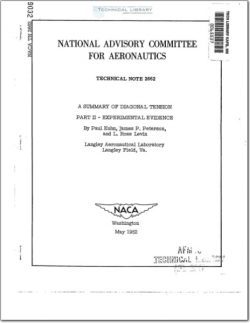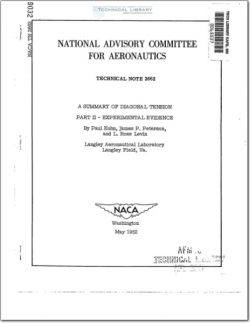NACA-TN-2662

- Version
- 454 Downloads
- 2.79 MB File Size
- 1 File Count
- December 4, 2015 Create Date
- December 4, 2015 Last Updated
National Advisory Committee for Aeronautics, Technical Notes - A Summary of Diagonal Tension Part II-Experimental Evidence

Methods of analyzing plane or curved shear webs in incomplete diago-
nal tension have been presented in Part I of this paper (reference 1).
These methods make liberal use of empirical relations, and a rather
large amount of space was devoted in Part I to general discussions of
the test results in order to furnish the background knowledge that was
felt to be desirable for anybody concerned with the application of the
methods.
Part II presents the test information in greater detail. It is
intended primarily for those who are interested in improving the methods
It should also be useful in interpreting specific tests such as might
be made in the course of demonstrating the strength of a specific
airplane.
All references to numbered formulas in the text refer to formulas
given in Part I; a list of symbols is also given in Part I.
The methods for analyzing plane diagonal-tension webs presented in
Part I may be considered to consist of a basic stress theory and of a
strength theory which is based on the basic stress theory.
The experimental evidence concerning the stress theory was obtained
mainly from NACA tests on beams, involving extensive strain measurements.
These tests are presented in some detail.
The experimental evidence on the strength theory is based on NACA
tests, including those just mentioned, and on tests made by aircraft
manufacturers. The main series of NACA tests comprised about 50 beams;
the manufacturers furnished a total of about 1&0 tests. Some of these
test results were given to the NACA with the stipulation that no test
details be published. For this reason, and also because a detailed
presentation of the data would be rather voluminous, the data from manu-
facturers' tests are presented only in summary form. The cooperation
extended by the manufacturers was very valuable, because many of the
strength formulas are partly or wholly empirical, and the large number
of additional tests greatLy increases the confidence that may be placed
in the formulas.
| File | Action |
|---|---|
| naca-tn-2662.pdf | Download |

Comment On This Post